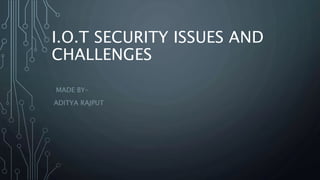
pptt.pptx
- 1. I.O.T SECURITY ISSUES AND CHALLENGES MADE BY- ADITYA RAJPUT
- 2. WHAT IS IOT? • IoT is computing devices that send data, receive date or both on the internet. • The Internet of Things (IoT) refers to the ever-growing network of physical objects that feature an IP address for internet connectivity, and the communication that occurs between these objects and other Internet-enabled devices and systems. • Where do we see it in our daily life?
- 3. UNDERSTANDING WHAT IS I.O.T SECURITY
- 4. THE HARDWARE IS TO BE BLAMED! Relatively modern 64-bit x86 CPU cores in I.o.T devices, they will still be substantially more complex than the smallest ARM cores, and therefore will need more battery power Cheap and disposable wearables, appear to be the biggest concern, won’t be powered by such chips. We need more powerful processors, such as Intel Atoms or ARMv8 chips, in smart products, like smart refrigerators or washing machines with touchscreens, but they are impractical for disposable devices with no displays and with limited battery capacity. The industry needs is more unstandardized devices and more fragmentation.
- 5. THE WEB APPLICATION SIDE OF IT! • “Weak authentication,” might thinking of passwords that are easy to guess. Unfortunately, the bar is much lower with many smart devices. • Generally I.o.T devices are secured with passwords like “1234”, put their password in client-side Java code, send credentials without using HTTPS or other encrypted transports, or require no passwords at all.
- 6. INSECURE NETWORK IN IOT DEVICES! • In your modern corporate network, you may think Telnet and FTP are dead, but the IOT smart device world would disagree. • August 2014, a sweep of more than 32,000 devices found “at least 2000 devices with hard-coded Telnet logins. • October 2014 research that demonstrated more than a million deployed routers were vulnerable.
- 7. INSECURE CLOUD AND MOBILE INTERFACE • Many IoT devices exchange information with an external cloud interface or ask end users to connect to a remote web server to work with their information or devices. In addition to obvious vulnerabilities such as a lack of HTTPS, the OWASP IoT Top Ten list asks you to look for authentication problems such as username harvesting (“user enumeration”) and no lockouts after a number of brute-force guessing attempts. • IoT devices may also act as wireless access points (WAPs).
- 8. INSECURE SOFTWARE/ FIRMWARE • Real life examples of corrupt update files abound, especially when people use “jailbroken” phones to disable the validation built in to their devices. MITM attacks using insecure update sources, such as the HTTP-based update vulnerability that affected ASUS RT routers in October 2014. • To test whether or not a device is using insecure updates, you generally need to use a proxy or sniffer to watch the data stream for use of secure transport, for example, an online utility called “APK Downloader” lets you download and inspect Android installations and updates on any platform.
- 9. PHYSICAL SECURITY OF IOT DEVICES • Five things to determine if a device’s exposed ports can be used for malicious purposes. These are ease of storage media removal, encryption of stored data, physical protection of USB and similar ports, ease of disassembly and removal or disabling of unnecessary ports.
- 10. SCOPE OF IOT SECURITY How many IoT devices do you own and use right now? How many does your business use? That’s where the “Internet of NoThings” joke comes from, most people don’t have any. The numbers keep going up, but the average consumer is not buying many, so where is that growth coming from? IoT devices are out there and the numbers are booming, driven by enterprise rather than the consumer market. Verizon and ABI Research estimate that there were 1.2 billion different devices connected to the internet last year, but by 2020, they expect as many as 5.4 billion B2B IoT connections.
- 11. IOT SPECIFIC SECURITY ASSESSMENT How it is a combination of different type assessments: Web interface Network services Secure Transport medium Cloud and Mobile interface Insecure Software/Firmware Physical security
- 12. I.O.T SECURITY: TRENDS, PROBLEMS AND CHALLENGES Problems and security challenges Many small devices have limited CPU power Not much processing power for security Need to look for new encryption scheme with less CPU power. Can not install AV software Example: IP-addressable light bulbs. I.o.T also needs both encryption key management and identity management It may scale into billions!
- 13. • Problems and security challenges • New devices for endpoint security • New firmware, embedded OS, new software & etc. • It is not possible to support AV on every device. • New transport protocols for making network security difficult! • Much more network traffic for security analysis • Bad news for large enterprises as network security is already complex and cumbersome
- 14. SEVEN IOT SECURITY RISKS*: 1. Disruption and denial-of-service attacks 2. Understanding the complexity of vulnerabilities 3. I.o.T vulnerability management 4. Identifying, implementing security controls 5. Fulfilling the need for security analytics capabilities 6. Modular hardware and software components 7. Rapid demand in bandwidth requirement
- 15. I.O.T SECURITY TOP 10 (OWASP 2014): I1 Insecure Web Interface I2 Insufficient Authentication/Authorization I3 Insecure Network Services I4 Lack of Transport Encryption I5 Privacy Concerns I6 Insecure Cloud Interface I7 Insecure Mobile Interface I8 Insufficient Security Configurability I9 Insecure Software/Firmware I10 Poor Physical Security
- 16. I.O.T WILL MERGE THE FOLLOWING DOMAINS:
- 17. A FEW SECURITY TECHNOLOGIES & I.O.T Simple taxonomy of I.o.T security
- 18. ANY QUESTIONS ?
- 19. THANK YOU